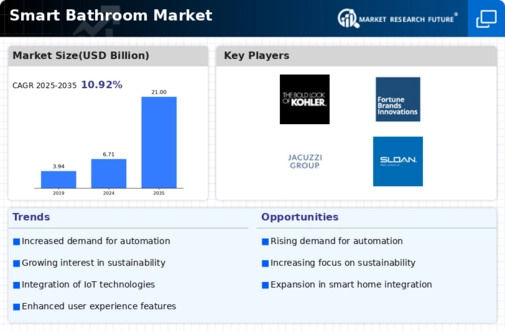Market Share
Smart Bathroom Market Share Analysis
Smart bathrooms require significant initial investments due to the incorporation of sensors and the need to connect various devices together. These bathrooms consist of advanced features such as hi-tech toilets, digital faucets, soaking tubs, and smart mirrors. The devices in smart bathrooms are voice activated and require technical expertise and connectivity. Because of the advanced technologies involved, these devices tend to be expensive. For instance, a smart toilet set can cost anywhere from USD 1000 to USD 10,000, depending on the functionalities it offers. Additionally, as technology advances and people become more aware of hygiene maintenance, there are innovative products like self-cleaning toilets. An example of this is a recently launched self-cleaning toilet in Chennai, India, which costs around USD 6500. It is considered to be the first of its kind in the country. Therefore, the high capital investment required is a significant factor that may hinder the growth of the smart bathroom market.
The high initial investment required for smart bathrooms is mainly due to the incorporation of advanced technologies and the need for connectivity. Sensors and devices need to be installed and connected together to create a smart bathroom environment. These sensors enable various functions such as automatic flushing, temperature control, and water conservation. Moreover, the devices in smart bathrooms are designed to be voice activated, meaning they can be controlled through voice commands. This level of technical expertise and connectivity adds to the overall cost of setting up a smart bathroom.
One of the key components of a smart bathroom is the hi-tech toilet. These toilets come equipped with features like seat warming, automatic lid opening and closing, and built-in bidets. The range of functionalities offered by these toilets directly affects their cost. Basic models with limited features may be more affordable, while advanced models with a wide range of functionalities can be quite expensive.
Another factor contributing to the high cost of smart bathrooms is the increasing focus on hygiene maintenance. Consumers are becoming more aware of the importance of cleanliness and sanitation in their bathrooms. This has led to the development of self-cleaning toilets, which are equipped with innovative technologies to maintain a high level of hygiene. The recently launched self-cleaning toilet in Chennai is a prime example of such innovation. These toilets use advanced cleaning mechanisms, such as automated disinfection and self-rinsing, to ensure cleanliness and minimize manual effort.
The market for smart bathrooms is still relatively niche, and the higher costs associated with setting up these advanced bathroom environments are a significant barrier to widespread adoption. However, as technology continues to advance and more manufacturers enter the market, it is expected that the prices of smart bathroom devices will gradually decrease. This will make them more accessible to a wider range of consumers, driving the growth of the smart bathroom market.
In conclusion, the high capital investment required is a major hindrance to the growth of the smart bathroom market. Incorporating sensors, connecting devices, and implementing advanced technologies contribute to the overall cost of setting up a smart bathroom. The range of functionalities offered by hi-tech toilets and the focus on hygiene maintenance also add to the expense. However, as technology advances and more manufacturers enter the market, it is expected that the prices of smart bathroom devices will become more affordable, leading to increased adoption and growth of the market.







Leave a Comment